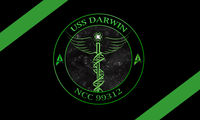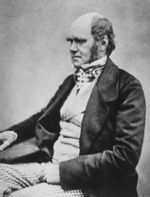Previous Vessels Named Darwin: Difference between revisions
Aigle Phos (talk | contribs) m (Changed nav position) |
No edit summary |
||
| Line 1: | Line 1: | ||
{{Template:Darwin_Side_Old}} | |||
{{Darwin-A-motto}} | {{Darwin-A-motto}} | ||
| Line 52: | Line 53: | ||
{{WikipediaContent}} | {{WikipediaContent}} | ||
{{Clear}} | {{Clear}} | ||
Revision as of 23:31, 13 February 2015
| USS Darwin-A | ||
|---|---|---|
 INACTIVE STATUS | ||
| ||
Charles Darwin (1809-1882)
Charles Darwin was a English naturalist and geologist born in Shrewsbury, England on the 12 February 1809. He is most well known for his contributions to evolutionary theory.
Initially a student of medicine, Darwin neglected his studies due to his interest of nature which lead him to help investigate marine invertebrates. This annoyed his Father leading him to send Darwin to Christ's College, Cambridge, for a Bachelor of Arts degree as the first step towards becoming an Anglican parson.
At the end of his degree, he was offered a place on the HMS Beagle as a self-funded 'gentleman naturalist'. The voyage began on the 27th of December, 1831 and lasted five years. During this time Darwin spent most of his time on land investigating geology and making natural history collections, while the Beagle surveyed and charted coasts. He also took zoology notes, mostly on marine invertebrates, specifically plankton.
Perhaps the most famous part of the mission was his investigation of the geologically new Galápagos Islands, where Darwin looked for evidence attaching wildlife to an older "centre of creation". His findings here would later play a big part in his theories.
When Darwin returned from his journey on the 2nd of October, 1836 he had developed into somewhat of a scientific celebrity due to the distribution of his letters containing observations and theories from his time on the Beagle. His success had also changed his Father's mind, and he was now willing to support Darwin as a gentleman scientist.
During the next few years, he refined his theories from the observations he had made, particularly on the Galápagos Islands, leading him to adopt the idea that "one species does change into another" as opposed to the accepted theory of Transmutation of species. This led him to develop his most famous work "The process of Natural Selection" in his book 'On the Origin of Species'.
Vessels named Darwin
Ships
- RT Darwin - Pusher/Tug
- Sealink Darwin - Special Purpose
- Darwin Pilot - Pilot tender
- King Darwin - Oil Products Tanker
- Odyssea Darwin - Platform supply vessel
- NDS Darwin - Yacht
- E R Darwin - Container ship
- Darwin 3 - Sailing ship
- Darwin - Container ship
- HMAS Darwin - Frigate
- MY Darwin - Yacht
- Charles Darwin - Dredger
- Charles Darwin - Dredger
- Charles Darwin - Ship
- Charles Darwin - Ship
- Charles Darwin - Ship
- MT Darwin Star - Oil tanker
Starships
The USS Darwin was a Nova Class vessel sent into the Ithassa Region to establish Starfleet's Presence. Primarily a transport, equipment, and supply vessel. Unfortunately, all hands were lost when it was attacked, and later used as bait for other federation ships by, the Grendellai. It was destroyed by Roumlans while the crew of the USS Independence were investigating romulan-federation hybrid technology aboard. Before the warp core breached the Independence was able to beam its crew off and vacate the area.
For more information see the USS Darwin
References
- Article on Charles Darwin, Wikipdia. Retrieved Jan. 14th 2014 from http://en.wikipedia.org/wiki/Charles_Darwin
- Vessel database, FleetMon. Retrieved Jan. 14th 2014 from http://www.fleetmon.com/en/vessels



